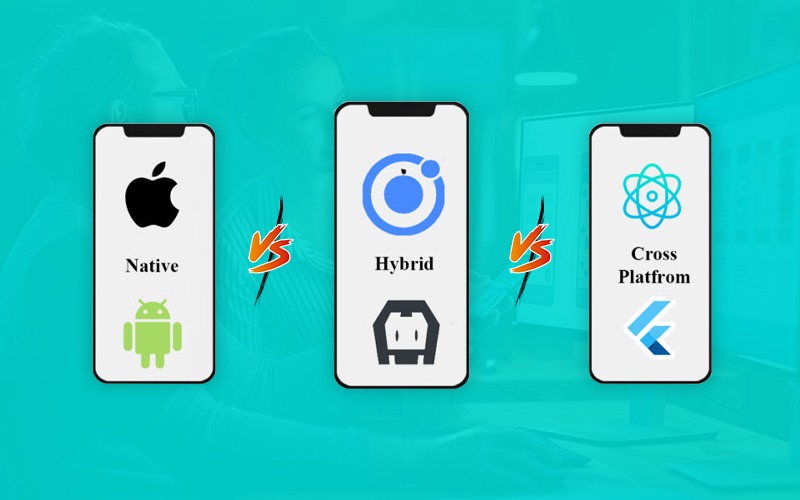You’ve got a brilliant idea for a mobile app. But before you dive headfirst into coding, you need to choose the right development approach. It’s like picking the perfect tool for the job – the wrong one can lead to frustration and delays.
So, let’s break down the three main approaches to mobile app development: native, hybrid, and cross-platform.
1. Native Apps: The Pinnacle of Performance
Imagine you’re building a house. You wouldn’t use the same tools for framing the walls and laying the foundation as you would for painting the interior. Native apps are like that – they’re built specifically for one platform, either iOS (using Swift or Objective-C) or Android (using Java or Kotlin), using the platform’s unique tools and languages.
Why choose native?
- Unmatched Performance: Native apps are like a finely tuned engine – they’re built to run smoothly and efficiently on the device, taking full advantage of its hardware and software. This means faster loading times, buttery-smooth animations, and a seamless user experience.
- Complete Access to Device Features: Native apps can tap into everything your phone has to offer – GPS, camera, Bluetooth, notifications, even advanced sensors like accelerometers and gyroscopes.
- Seamless User Experience: Native apps look and feel like they belong on the platform they’re built for. They follow the design guidelines and conventions of iOS and Android, creating a familiar and intuitive experience.
But there’s a catch:
- Higher Development Cost: Building two separate apps, one for iOS and one for Android, means double the development time and resources.
- Longer Time to Market: Maintaining two separate codebases takes time, which can slow down the development process and delay your app’s launch.
- Maintenance Challenges: Updating and maintaining two separate codebases can be a logistical headache.
When is Native development the right choice?
- High-Performance Apps: Games, graphics-intensive applications, or apps that require real-time interaction and responsiveness.
- Apps Heavily Relying on Device Features: Apps that utilize GPS, camera, Bluetooth, or other advanced hardware capabilities.
- Apps With a Strong Emphasis on User Experience: If seamless performance, platform-specific design, and a polished user experience are your top priorities.
2. Hybrid Mobile App: Web Technologies in a Native Shell
Think of a website you love – now imagine it running on your phone as a native app. That’s the magic of hybrid apps! They use web technologies like HTML, CSS, and JavaScript to create the app’s content, but they’re wrapped in a native container (like Cordova or Ionic) that provides access to some device features.
Why choose hybrid?
- Faster Development: You’re essentially building one app that can run on both iOS and Android, saving time and resources.
- Cross-Platform Compatibility: Reach a wider audience by targeting both iOS and Android users with a single codebase.
- Easier Maintenance: Maintaining one codebase for both platforms is significantly simpler than managing two separate codebases.
But there are some trade-offs:
- Performance Trade-offs: Hybrid apps can be slower and less responsive than native apps, particularly with complex tasks or heavy graphics.
- Limited Access to Device Features: While hybrid apps can tap into some native features, their access might not be as comprehensive or performant as native apps.
- User Interface Limitations: Hybrid apps might not achieve the same level of native look and feel, leading to a less polished user experience.
When is Hybrid development a good option?
- Simple Apps with Limited Functionality: If you need a basic app with minimal device features and a focus on web-based content, hybrid development can be efficient.
- Rapid Prototyping: Hybrid apps are great for quickly testing ideas and validating concepts, allowing you to iterate quickly and adjust based on user feedback.
- Limited Budget: Hybrid development can be more affordable than native development, especially for smaller projects.
3. Cross-Platform Apps: The Best of Both Worlds?
Cross-platform apps are like a bridge between native and hybrid development. They utilize frameworks like React Native (built by Facebook), Flutter (developed by Google), or Xamarin (developed by Microsoft) to write code once and deploy it to multiple platforms.
Think of it like building with LEGOs. You create a set of building blocks that can be assembled into different models, representing apps for iOS and Android.
Why choose cross-platform?
- Faster Development and Deployment: Writing code once for both platforms saves a significant amount of time and resources.
- Cross-Platform Compatibility: Reach a wider audience by targeting both iOS and Android users with a single codebase.
- Good Performance: Cross-platform apps are getting increasingly powerful, offering performance that is closer to native apps, especially with frameworks like React Native and Flutter.
But there are some limitations:
- Potential Performance Trade-offs: While cross-platform apps are rapidly improving, they might still lag slightly behind native apps in certain scenarios, especially with highly demanding or complex applications.
- Limited Access to Platform-Specific Features: Cross-platform frameworks might not always provide access to all the latest native features and APIs, which could limit the app’s functionality.
- Potentially Less Native Look and Feel: Cross-platform apps might not fully mimic the native look and feel of each platform, although recent frameworks have made significant progress in this area.
When is Cross-Platform development the right choice?
- Medium to Complex Apps with Cross-Platform Requirements: If you need an app with moderate complexity and good performance, but want to avoid the cost and time of native development, cross-platform frameworks are a great option.
- Apps with a Focus on User Experience: Frameworks like React Native and Flutter have made tremendous strides in providing a near-native user experience.
- Apps with Evolving Needs: Cross-platform apps are easier to adapt and update for new platforms or features, allowing you to respond quickly to changing market demands.
Choosing the Right Path: The Perfect Fit for Your Mobile / Web App
Ultimately, the best development approach depends on your specific needs:
- Native: Ideal for high-performance, feature-rich apps with a strong emphasis on platform-specific user experience and a generous budget.
- Hybrid: Great for simple, web-based apps (mobile app) with limited device requirements and a tighter budget.
- Cross-Platform: Offers a balanced approach, providing faster development, cross-platform compatibility, and good performance for moderately complex apps.
Don’t be afraid to experiment! You might start with a hybrid prototype and then transition to a native or cross-platform approach as your app’s needs evolve.
The key is to choose the right tool for the job, so you can build a successful and engaging mobile app that meets your users’ needs and drives your business forward.







Leave a Comment